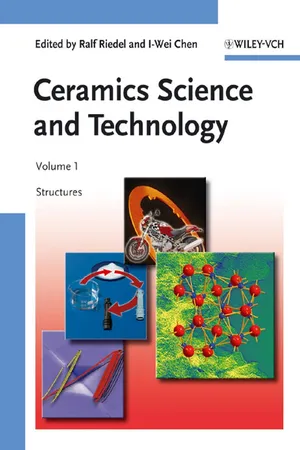Technology & Engineering
Microstructure of Ceramics
The microstructure of ceramics refers to the arrangement of grains, pores, and other features at a microscopic level within the material. It greatly influences the mechanical, thermal, and electrical properties of ceramics. Understanding and controlling the microstructure is crucial for optimizing the performance and functionality of ceramic materials in various engineering applications.
Written by Perlego with AI-assistance
Related key terms
Related key terms
1 of 4
Related key terms
1 of 3
3 Key excerpts on "Microstructure of Ceramics"
- eBook - ePub
- Ralf Riedel, I-Wei Chen, Ralf Riedel, I-Wei Chen(Authors)
- 2015(Publication Date)
- Wiley-VCH(Publisher)
6 Microstructural Design of Ceramics: Theory and ExperimentGayle S. Painter and Paul F. Becher6.1 Overview
The chemical bonding and electronic structure of condensed matter form the fundamental basis for an understanding of the diverse properties of materials. An even greater spectrum of properties, phenomena and behavior comes from the coupling of these properties over various length scales, giving rise to the materials’ microstructure. Ceramic materials possess compositional complexity, and also display a rich diversity of properties and behavior as a consequence of the resulting variable microstructure. Much is to be learned by understanding how variations in the properties of materials are associated with the underlying microstructure. In this chapter, the current state of understanding of: (i) what determines microstructure in ceramics; and (ii) how microstructure affects observed properties and behavior, is examined. Clearly, although microstructural effects on the electronic properties of ceramics may be important, in this chapter the discussion is limited to structural ceramics and mechanical behavior. The aim of this chapter is to describe how microstructure is determined by fundamental materials characteristics, and how an understanding of microstructure is enhanced through theory and modeling.The first question, therefore, is what is meant by the term microstructure? Microstructure can imply several things because: (i) micro is frequently used in a dimensional sense (smallness) that is more general than the micron scale; and (ii) structure indicates spatial (or temporal) inhomogeneity. In this chapter, the term microstructure is used in this general sense: a material property inhomogeneity over length scales extending from sub-nanometer to millimeter. Over the past decade or two, the term nanostructure has become pervasive, although here the dimensional aspect is usually implied. For length - Pascal Richet, Pascal Richet(Authors)
- 2021(Publication Date)
- Wiley-American Ceramic Society(Publisher)
2.3 Microstructure Analysis of Glasses and Glass Ceramics Christian Patzig and Thomas Höche Fraunhofer Institute for Microstructure of Materials and Systems IMWS, Halle (Saale), Germany 1 Introduction A homogeneous glass by definition lacks a microstructure at a scale larger than a few nanometers. As soon as actual inhomogeneities occur, in contrast, a detailed picture of their size, distribution, composition, and spatial arrangement becomes important to understand the properties of the material. In turn, the improved capabilities of microstructural studies in terms of spatial and elemental resolution are becoming increasingly important to optimize crystallization or phase separation and to achieve the desired microstructure and associated properties (Chapter 7.11). As a matter of fact, the beauty and challenge of glasses and glass ceramics is their diversity and complexity. The purpose of this chapter thus is to review the main microstructural methods commonly used to study inhomogeneous glass‐based materials. In preamble, however, it is important to note that studying extremely small volumes in great detail can result in “knowing everything about nothing.” In other words, it is critically important to make sure that the information gathered locally is actually representative for larger volumes. To achieve this goal, highly resolved information must be combined with additional integral measurements to get a broad picture. In addition, artifacts introduced upon either preparation or investigation of the sample must be avoided. And one should also be extremely careful with in situ microstructural experiments where, because of dramatic differences in the surface‐to‐volume ratio, annealing can easily lead to results not observed in the bulk- eBook - ePub
- Hani M. Tawancy, Anwar Ul-Hamid, Nureddin M. Abbas(Authors)
- 2004(Publication Date)
- CRC Press(Publisher)
8 Materials Characterization 8.1 Introduction Materials characterization is almost always involved in failure analysis investigations. It requires knowledge of the overall composition of the material, as well as its microstructural features. Chemical composition refers to the elemental constituents of the material and their concentrations. By definition, microstruc- ture refers to the internal structural features of a material which cannot be visually observed. They are to be distinguished from macrostructural features such as large cracks, porosity, and fracture characteristics which can be observed either visually or by using a low-power hand lens. Complete microstructural characterization of a given material requires determination of (i) morphology (size, shape, and distribution of all phases present), (ii) crystal structure of all phases present, and (iii) elemental composition of all phases present, including localized segregation and depletion. Since some techniques for chemical analysis are associated with certain methods used to reveal the microstruc- ture, techniques for microstructural characterization are described first. Various techniques for chemical analysis are described in Sec. 8.3. As described below, there are various techniques available for microstructural characterization. Selection of one technique or another depends upon the type of information required. 8.2 Techniques for Microstructural Characterization Microstructural features of a material are revealed by means of a high-power microscope. Its primary function is to form an image of an object, as schematically illustrated in Fig. 8.1. To observe the microstructure of a material, a representative specimen is illuminated by a suitable source of radiation. Radiation emitted by the specimen is then gathered by an objective lens and focused into an image
Index pages curate the most relevant extracts from our library of academic textbooks. They’ve been created using an in-house natural language model (NLM), each adding context and meaning to key research topics.
Explore more topic indexes
Explore more topic indexes
1 of 6
Explore more topic indexes
1 of 4


